As the sun sets, the cool evening breeze whispers a secret. It’s hidden in your garden, beneath the soil. The Crocus sativus bulbs are waiting to shine, ready to reveal the precious saffron threads.
Imagine harvesting your own saffron. The vibrant crimson strands will add a unique aroma and flavor to your dishes. It’s a thrilling experience.
Growing crocus sativus bulbs is a journey of discovery. It connects you with the earth and brings ancient spice essence into your kitchen. Whether you’re a seasoned gardener or a beginner, the rewards are unmatched.
Let’s explore the rich history and captivating benefits of saffron cultivation. Together, we’ll transform your garden into a bountiful source of this precious culinary treasure.
Table of Contents
What is Crocus Sativus?
Crocus sativus, also known as the saffron crocus, is a stunning flower that has amazed people for centuries. Its bright purple color is the key to the prized spice, saffron. This spice is loved for its unique taste, smell, and ability to add color to dishes.
Understanding the Saffron Crocus
The saffron crocus is a perennial plant from the Iridaceae family. It grows up to 10 cm tall and needs well-drained soil. In the fall, its purple flowers open, revealing red stigmas. These stigmas are carefully picked to make saffron spice.
History and Origin of Saffron
Saffron’s history goes back to ancient times. It was first mentioned in Minoan-era Crete and ancient Egypt around 2,100 B.C.E. In the 17th century, it was brought to the United States. Now, it’s a key part of many foods and gardening traditions.
Botany and Characteristics of Crocus Sativus
Crocus sativus is part of the Crocus genus with almost 100 species. These plants can handle frost and grow well in USDA Hardiness Zones 3-8. They add color to spring gardens. Plant the corms 15 cm deep in well-drained soil for the best blooms.
| Crocus Sativus Characteristics | Details |
|---|---|
| Price per Bulb | $12.90 (or $12.40 for 2+ bulbs, $11.90 for 5+ bulbs) |
| Bulbs in Stock | 676 |
| Planting Depth | 15 cm |
| Plant Height | 10 cm |
| Availability | November to March |
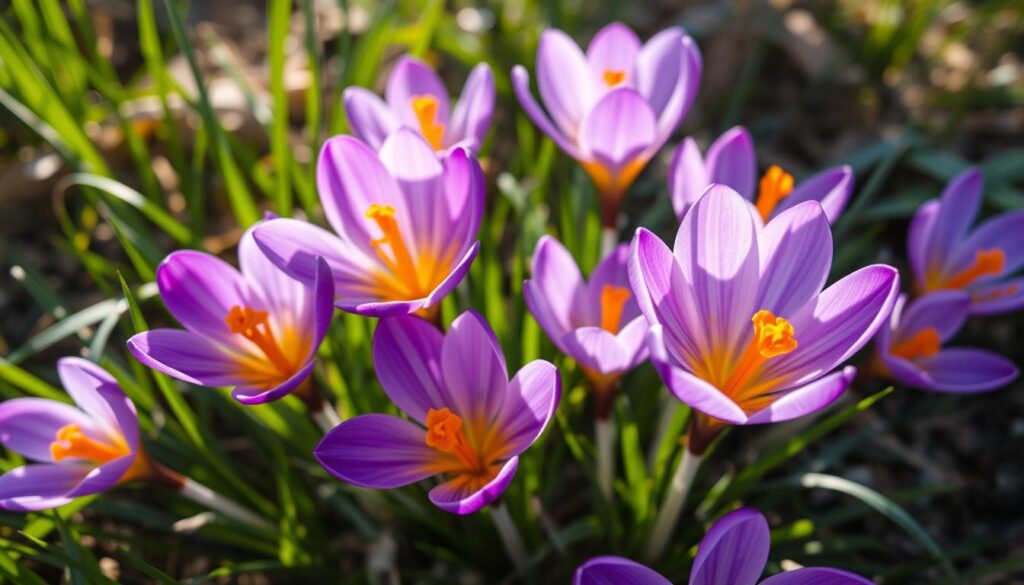
The saffron crocus has amazed the world for centuries. Its purple flowers and red stigmas are highly valued. Knowing its history, botany, and characteristics helps us see its true worth.
Benefits of Growing Crocus Sativus Bulbs
Growing Crocus sativus, the source of saffron, brings many benefits. Saffron is known for its unique aroma, bright color, and wide use in cooking. It adds flavor and beauty to many dishes.
Culinary Uses of Saffron
Saffron is a key ingredient in many recipes. It makes rice dishes like biryani and pulao taste amazing. It also adds a special touch to desserts like kheer and kulfi.
Its distinct flavor and color are loved by chefs and home cooks. Saffron makes dishes stand out and taste better.
Health Benefits of Saffron
Saffron is also good for your health. It has compounds that fight inflammation and boost the immune system. Research shows it may help with Alzheimer’s, depression, and heart disease.
Adding saffron to your meals can help keep you healthy naturally. It’s a natural way to improve your well-being.
Economic Value of Homegrown Saffron
Growing saffron can also save you money. Saffron is very expensive, but high-quality threads can be sold for a lot. By growing your own, you can save money and enjoy the process.
Growing Crocus sativus offers many benefits. It’s great for cooking, health, and even your wallet. It’s a rewarding crop for gardeners of all levels.
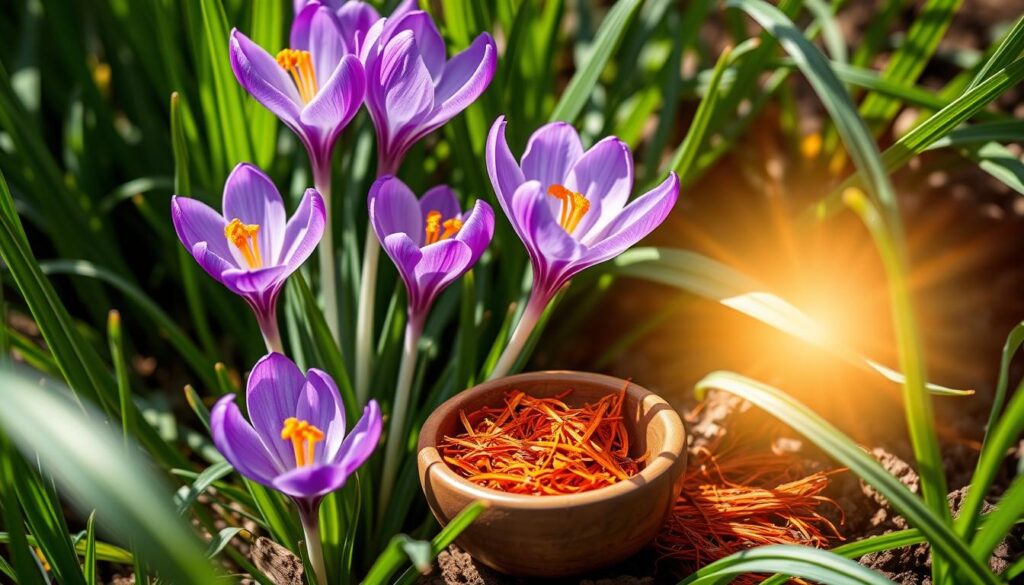
Choosing the Right Location for Planting
When growing saffron, picking the right spot is key. Saffron, known as the “red gold,” needs certain weather and soil to grow well. It does best in well-drained soil.
Sunlight Requirements
Saffron crocus plants love the sun. They need at least 6 hours of direct sunlight a day. The best spot gets full sun all day for the best growth and flower production.
Don’t plant in shady spots or under trees. Too much shade can block sunlight from reaching the plants.
Soil Type and Preparation
Saffron crocus likes well-drained, loose soil with a pH of 6 to 8. The soil should be rich in organic matter and have a sandy or loamy texture. This helps with drainage.
Before planting, add compost or well-rotted manure to the soil. This improves its nutrient content and structure.
Drainage Considerations
Good drainage is vital for growing saffron. Waterlogged soil can rot the bulbs. Make sure the planting area drains well.
Use raised beds or a gentle slope to help water drain. If your soil is heavy, mix in sand or gravel to improve drainage.
By choosing a location with the right sunlight, soil, and drainage, you’ll grow a lot of saffron. This precious spice will be yours to enjoy.
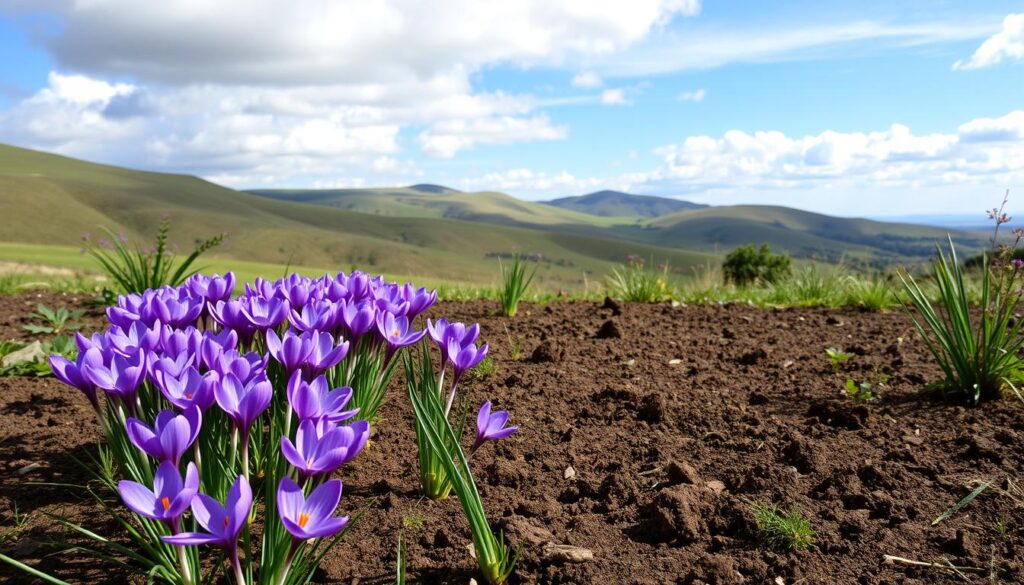
“Saffron requires a minimum of 6 hours of direct sunlight each day to thrive and produce high-quality flowers.”
Success in growing saffron comes from balancing sunlight, soil, and drainage. Focus on these factors to create the perfect environment for your saffron plants.
Planting Crocus Sativus Bulbs
Planting saffron bulbs, or Crocus sativus corms, is key to growing your own saffron. The best time is summer, from July to September. This is when the soil drains well and the weather is warm. Follow a planting guide and use the right spacing and depth for a successful harvest.
Best Time for Planting
The best time to plant Crocus sativus bulbs is in late summer, from July to September. This lets the bulbs grow strong roots before the cooler months. Planting then gives them enough time to bloom beautifully in the fall.
Step-by-Step Planting Guide
- Choose a sunny spot with well-drained soil for your saffron bed.
- Loosen the soil 8-10 inches deep, adding compost to make it better.
- Plant the corms 3-4 inches deep, with the pointed end up.
- Space them 4-6 inches apart in rows or a grid for best growth.
- Water gently, avoiding puddles.
- Use 2-3 inches of organic mulch to keep moisture in and weeds out.
Spacing and Depth Recommendations
For planting Crocus sativus bulbs, follow these spacing and depth tips. Plant 3-4 inches deep, with the pointed end up. Space them 4-6 inches apart for enough room to grow and bloom.
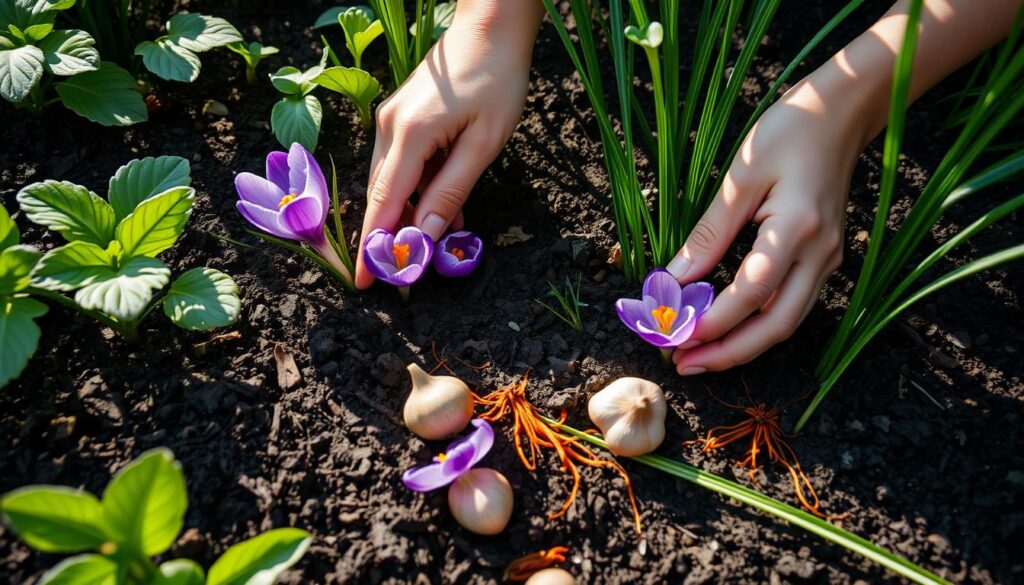
By following these planting tips, you’re on your way to a great saffron harvest. With the right methods and timing, you can enjoy saffron’s taste and beauty in your garden.
Caring for Your Crocus Sativus Plants
To keep your saffron plant (Crocus sativus) healthy, pay close attention to its needs. This includes the right amount of water, proper food, and keeping pests and diseases away. By following these tips, your saffron plants will grow well.
Watering Guidelines
Saffron plants don’t like too much or too little water. They do best in temperatures between 15°C to 25°C (59°F to 77°F). This helps prevent them from getting stressed and wilting.
It’s important to check the soil moisture often. If the soil is too dry or wet, it can cause the plants to wilt. A good way to help a wilted plant is to water it from the bottom. This method helps the roots grow strong and keeps the plant hydrated.
Fertilization Tips
Give your saffron plants a balanced, slow-release fertilizer in early spring. This is when they start growing from the soil. It gives them the nutrients they need for healthy leaves and lots of flowers.
But don’t overdo it with the fertilizer. Too much can make the plants grow too much foliage and not enough flowers.
Pest and Disease Management
Watching out for pests and diseases is crucial for your saffron plants. Check them regularly for any signs of bugs or fungi. If you see any, act fast to stop it from spreading.
Diseases can also cause wilting in saffron plants. This is rare but can happen. To avoid this, take good care of your plants and cut off any damaged leaves. This helps them grow new and keeps diseases away.
By taking care of your saffron plants’ watering, fertilizing, and pest and disease management, you’ll keep them healthy and productive for a long time.
Harvesting Saffron from Crocus Sativus
Harvesting saffron, the world’s most precious spice, from Crocus sativus plants is a delicate and labor-intensive process. But the rewards are well worth the effort. To get high-quality saffron threads, timing and proper harvesting techniques are crucial.
Timing the Harvest
The best time to harvest saffron is in the early morning. This is when the vibrant purple flowers bloom in autumn. The delicate red stigmas, which are the source of the prized saffron, are at their peak freshness and potency.
Proper Harvesting Techniques
- Carefully hand-pick the saffron stigmas, ensuring they remain intact and undamaged.
- Avoid handling the stigmas excessively, as this can compromise their flavor and aroma.
- Work swiftly and efficiently, as the saffron stigmas need to be processed soon after harvesting for optimal quality.
Post-Harvest Processing
After harvesting, the next step is to process the saffron stigmas. This preserves their valuable properties. Here’s how:
- Drying the saffron threads in a cool, dry, and well-ventilated area to prevent moisture buildup.
- Storing the dried saffron threads in airtight containers, away from direct sunlight, to maintain their vibrant color and potent flavor.
By following these steps, you can ensure that your homegrown saffron retains its distinctive aroma, deep red color, and unparalleled culinary and medicinal properties.
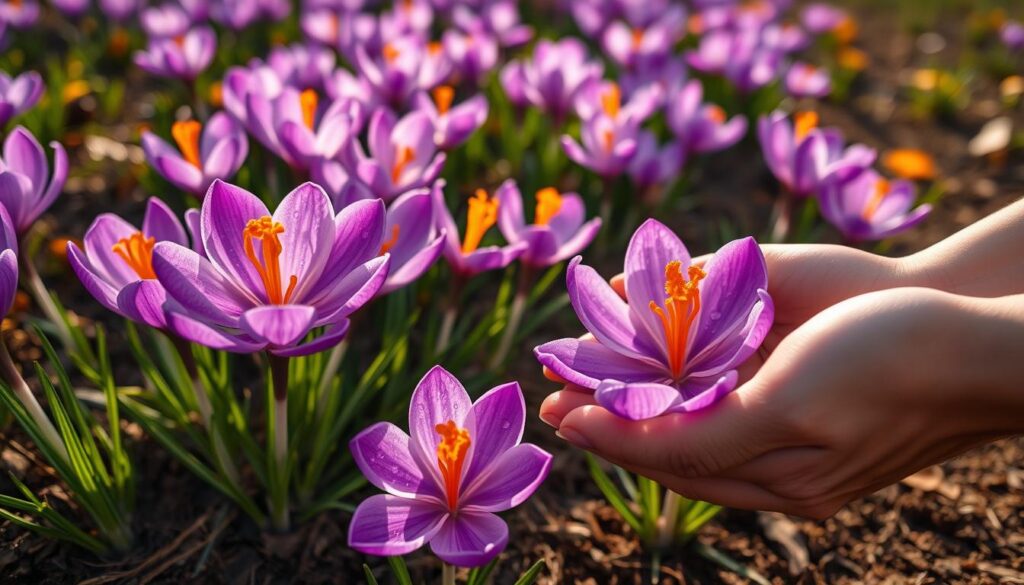
| Saffron Harvesting Stages | Description |
|---|---|
| Timing the Harvest | Harvest saffron stigmas in the early morning during the autumn bloom |
| Harvesting Technique | Carefully hand-pick the saffron stigmas, avoiding excessive handling |
| Post-Harvest Processing | Dry the saffron threads and store them in airtight containers |
“Saffron, the world’s most expensive spice, is a true labor of love. Its cultivation and harvesting require meticulous attention to detail, but the rewards are unparalleled.”
Preserving and Storing Saffron
Keeping your saffron fresh is key to its quality and taste. Use the right drying methods and storage tips to keep your saffron fresh. This way, you can enjoy its unique flavor and aroma for a long time.
Drying Saffron Threads
First, dry the saffron stigmas well. Lay them out on a clean, dry spot, out of the sun. Let them dry for 24-48 hours until they’re dry and crumbly. This step keeps the saffron’s oils and flavors locked in, making it vibrant and flavorful.
Best Storage Practices
- Put the dried saffron in an airtight container, like a glass jar or tin. This keeps air and moisture out.
- Store it in a cool, dark spot, away from sunlight and heat. This helps keep the saffron fresh longer.
- Adding a desiccant packet in the container helps absorb any extra moisture. It keeps the storage area perfect.
Shelf Life of Saffron
Properly stored, your saffron can stay good for 2-3 years. But, check it often for any color changes or loss of smell. If you see any issues, use it right away for the best taste and quality.
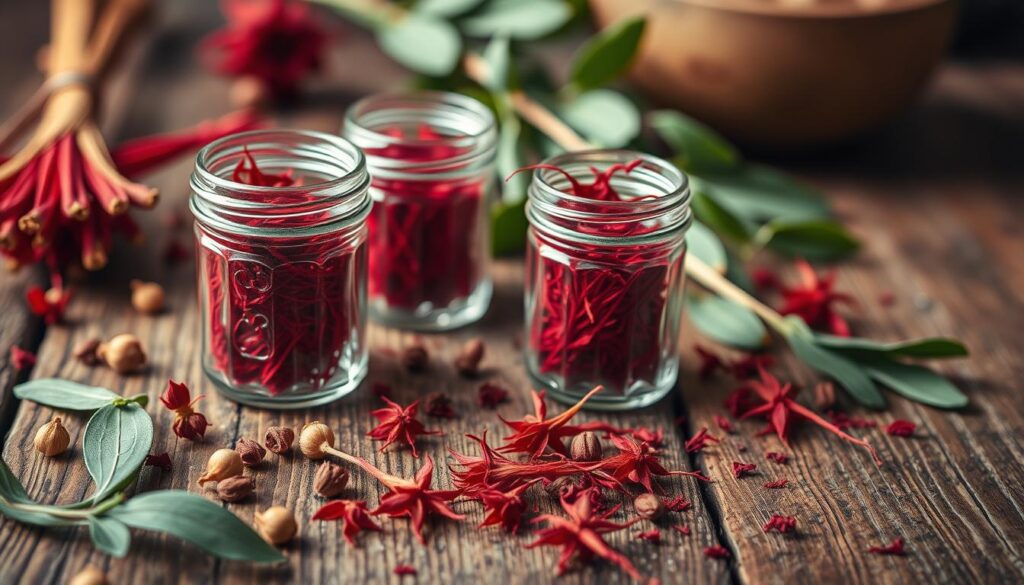
By drying and storing your saffron right, you’ll keep its quality high. It will be a valuable ingredient in your cooking for many years.
Common Mistakes to Avoid
Growing saffron at home can be very rewarding. But, it’s key to avoid common mistakes to get a good harvest. Knowing these pitfalls helps you grow more saffron and enjoy the taste of your own spice.
Overwatering Issues
One big mistake is overwatering. Saffron crocus likes dry soil to avoid root rot. Make sure your plants get the right water and watch for signs of too much water like yellow leaves.
Mismanagement of Soil Quality
Soil quality is very important for saffron. It needs rich, well-draining soil with a neutral pH. Bad soil can make plants weak and reduce saffron production.
Improper Harvesting Techniques
Harvesting saffron threads needs care. Wrong methods can hurt the quality and amount of saffron. Learn the right way to pick the stigmas to get the best results.
Avoiding these mistakes can help you grow a healthy saffron crop. This way, you can enjoy the unique taste and smell of your homemade spice.
Frequently Asked Questions about Crocus Sativus Bulbs
Are you excited to grow saffron at home? You might have some questions about Crocus sativus bulbs. Let’s answer some common ones to help you grow this valuable spice.
Many people wonder how long Crocus sativus bulbs last. These bulbs are perennials and can be productive for years with the right care. With good growing conditions, your saffron crocus plants can give you saffron for 3-5 years or more.
Some also ask if you can grow Crocus sativus in containers. Yes, you can! These bulbs do well in pots, perfect for those with little space. Just pick a deep, well-draining pot and make sure it gets enough sunlight and has the right soil.
FAQ
What is the lifespan of crocus sativus bulbs?
Crocus sativus bulbs, also known as saffron corms, can live for 5-10 years. This is with the right care and growing conditions.
Can crocus sativus be grown in containers?
Yes, you can grow crocus sativus in containers. Make sure they have good drainage and get enough sunlight.
What are the ideal climate conditions for growing crocus sativus?
It loves dry summers and cool, damp winters. This is similar to its native Kashmir region.
How long does it take to grow saffron from crocus sativus bulbs?
It takes 3-4 years for the bulbs to mature. Then, you can harvest your first saffron.
Can crocus sativus be grown in different soil types?
While it prefers well-drained, rich soil, it can grow in various soils. Just make sure the soil is well-prepared and drains well.
How much saffron can be harvested from a single crocus sativus plant?
A single plant can yield 0.5-1 gram of dried saffron threads. The amount can vary.
Can crocus sativus be propagated from seeds?
Yes, it can be grown from seeds. But dividing and replanting the corms is more common and efficient.
What are the common pests and diseases that can affect crocus sativus plants?
Aphids, nematodes, and fungal diseases like corm rot can harm it. Keep an eye out and use integrated pest management.
Can crocus sativus be grown indoors or in greenhouses?
Yes, it can thrive indoors or in greenhouses. But it needs specific light, temperature, and humidity conditions.
How can I maximize the yield of saffron from my crocus sativus plants?
For the best yield, ensure the right growing conditions. Follow proper planting and harvesting. Also, manage pests and diseases well.

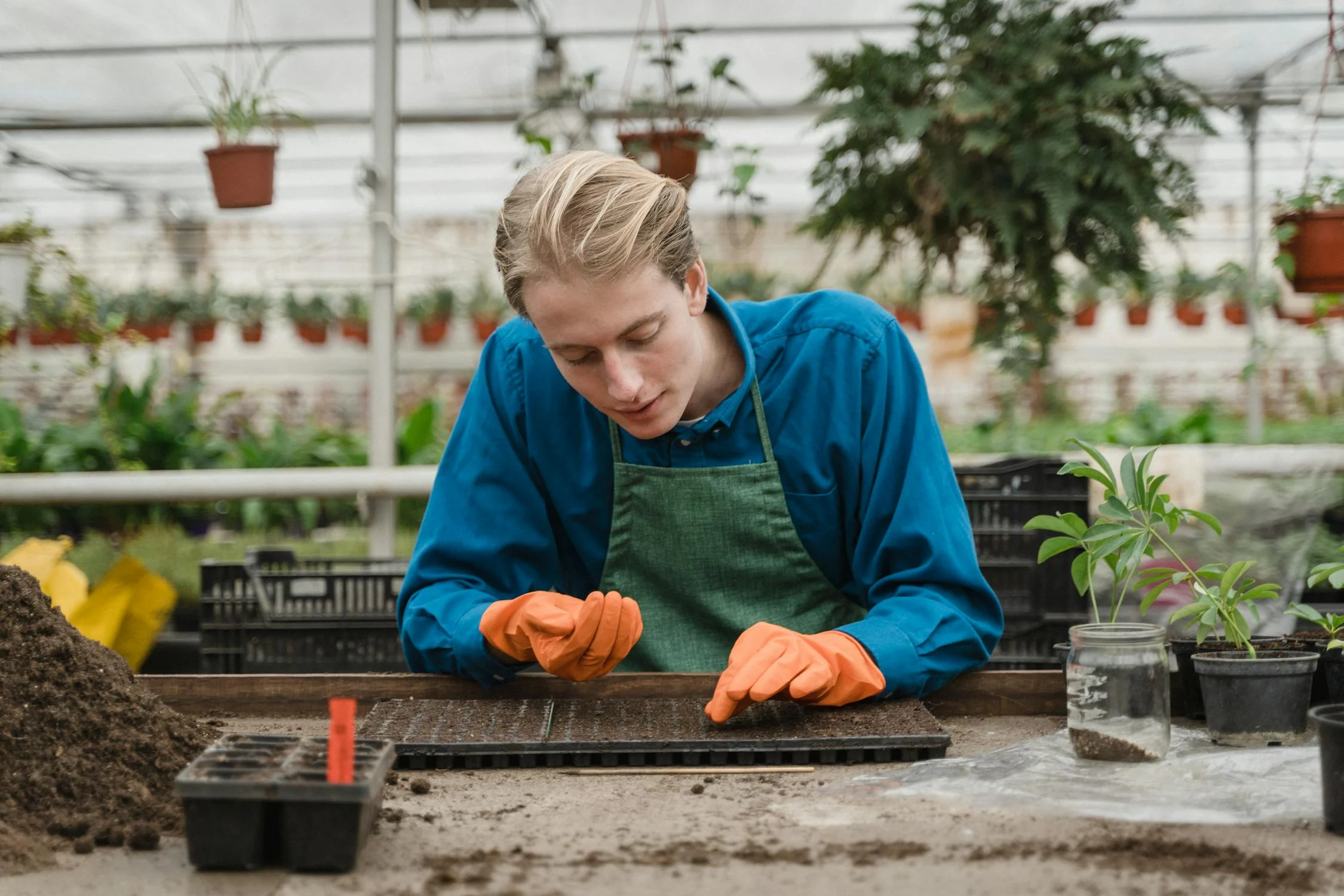
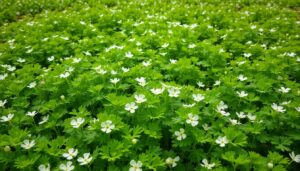








1 thought on “Grow Crocus Sativus Bulbs for Homegrown Saffron”